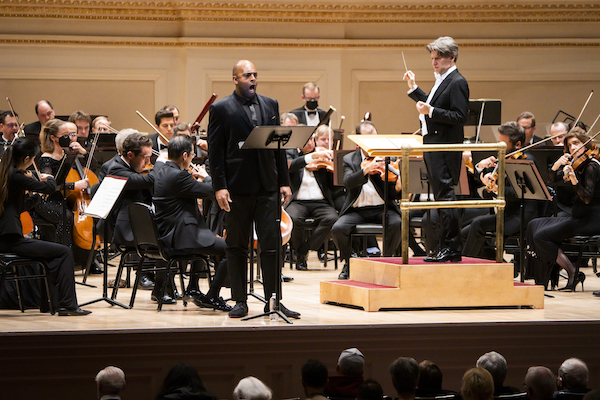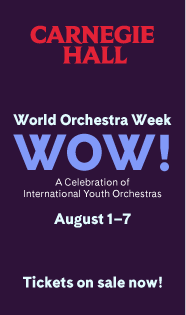Rustioni brings dramatic impact, sonic splender to Met Orchestra concert

The Met Orchestra returned to Carnegie Hall on Saturday evening in a crowd-pleasing concert of Slavic music conducted by Daniele Rustioni.
The operas of Bartók and Stravinsky are hardly mainstays of the opera repertoire, but their orchestral works are another matter. Add bass-baritone Ryan Speedo Green, in one of his all-too-rare New York concert appearances, singing Mussorgsky’s Songs and Dances of Death, and you have opera lovers happy too.
Rustioni will be leading Verdi’s Falstaff at the Metropolitan Opera in March. Youthful, lithe, and athletic, the Milan-born conductor is a captivating presence on the podium. He brought excitement, as well as finesse, to the music and the Met Orchestra sounded fantastic on the stage of Carnegie Hall under his baton.
Bartók composed the Concerto for Orchestra in 1943 on a commission from Serge Koussevitzky. The composer had fled to America from Hungary in 1940 as the Nazi’s tightened their grip on Europe. Ill and short of money, he struggled to find his artistic footing in the United States. Koussevitzky and the Boston Symphony Orchestra gave the work in New York premiere at Carnegie Hall in 1945. It was the same year that the composer died, having had had little time to savor Concerto for Orchestra’s enduring popularity.
Rustioni led a performance that emphasized the prevailing pensive quality of the score. He was enabled in these efforts by the gossamer-like playing of the strings. Solo turns were deftly executed and the fugue in the Finale was etched to perfection. But was the shimmering sounds of the violins and violas hanging over the orchestra like a cloud that seemed to suspend time.
Composed between 1875 and 1877, Mussorgsky’s Songs and Dance of Death are four gripping depictions of fatal encounters with the end of life. They were performed in Shostakovich’s 1962 orchestral arrangement, which he crafted for soprano Galina Vishnevskaya, who premiered it with her husband Mstislav Rostropovich conducting. It was touching to read in the program that the first full performance of the Shostakovich arrangements in Carnegie Hall were by the late Russian baritone Dmitri Hvorostovsky in 1999.
Green, who was a member of the Met’s Lindemann Young Artist Development Program, is returning to the Met in April as the young boxer Emile Griffith in Terrence Blanchard’s Champion. Green has a powerhouse of a voice that is as strong, as it is beautiful.
The songs revealed a more subtle aspect of Green’s art. He was superb in creating mood and character through a wide range of dynamics and vocal colors. At any volume, the voice was rich, even and beautiful throughout its range. In ‘Lullaby’, the first of the four songs, Green combined a hushed seductive quality with a sinister leer that made the death of an infant all the more horrible. The seductiveness turned to ardor when he sang of a young woman’s lovely visage, golden tresses and blue eyes in “Serenade”.
His voice was as menacing as the feverish tunes played by the orchestra in “Russian Dances”. With an evil glint in his eye, Green held a finger to his lips to hush the din, in order that the song of a skylark singing over the grave of a poor peasant whom death claimed on a snowy night could be heard. In the final song of the four, “The Field Marshall”, Rustioni gave free rein to the orchestra as Green sang of Death triumphantly surveying the ghastly carnage of battle.
The final work on the program was Stravinsky’s 1919 Suite from The Firebird. Completed in 1910, it was the first of Stravinsky’s ballets that propelled him to fame. He dismissed it as an “audience lollipop”, but a more apt description may have been a fabulous display of musical fireworks.
In this performance, Rustioni leaned as heavily on Stravinsky’s debt to earlier Russian composers, as he did to the young composer’s innovative genius. The brilliant colors that Rustioni summoned from the orchestra instantly called to mind the music of his teacher Rimsky-Korsakov, but there were other flashbacks as well. The great slashes of brass in the finale summoned “The Great Gate of Kiev” from Mussorgsky’s Pictures at an Exhibition.
It was an exhilarating performance.“The “Dance of the Firebird” and the feverish “Infernal Dance of King Kashchei” were extravagant displays of exotic colors and rhythms. In closing measures of the ‘Berceuse”, Rustioni crouched low to achieve the most shimmering of pianissimi. The attacca that followed caused people to jump out of their seats.
Among the sonic splendors, however, the solo turns in the woodwinds and brass stood out. They are always wonderful at the Met, but there was a vibrancy to their sounds that had nothing to do with volume, but more the acoustical vibrancy that comes from being center stage at Carnegie Hall.
The Met Orchestra returns to Carnegie Hall on June 15 with Yannick Nézet-Séguin leading Brahms’ German Requiem. carnegiehall.org
